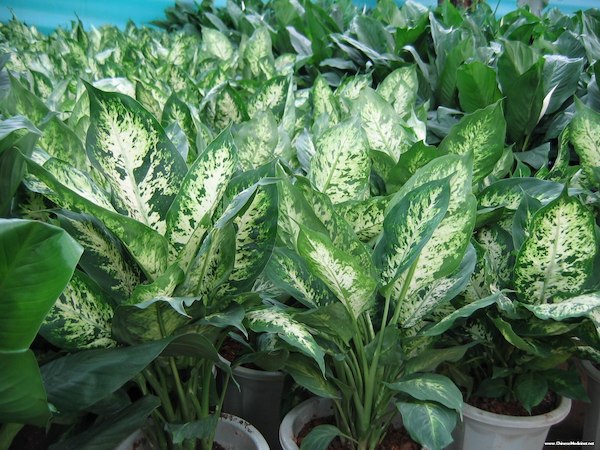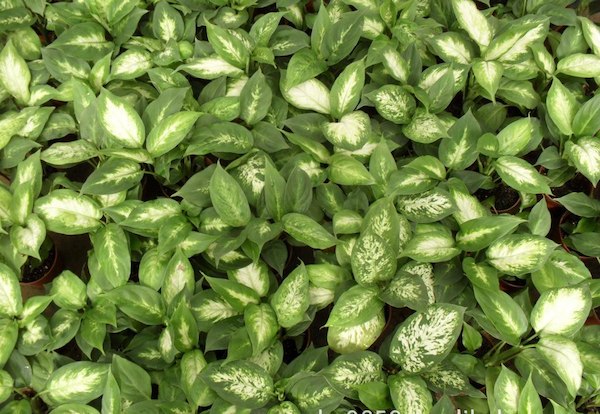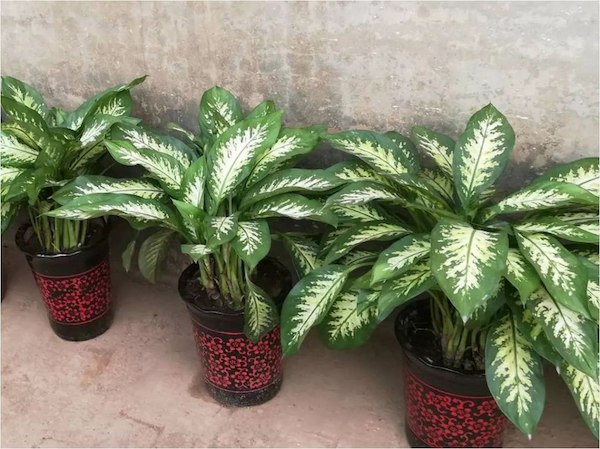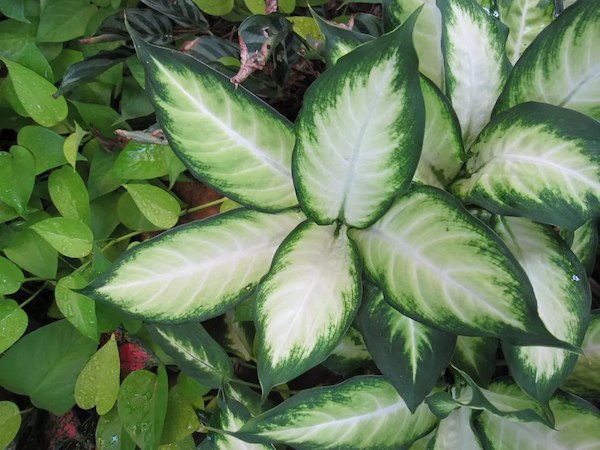Dumb Cane (Dieffenbachia): Plant Care & Growing Guide
Written by lisa
Nov 30 2021

Dumb Cane (scientific name: Dieffenbachia) is an evergreen shrubby herb with thick, fleshy stems that can reach up to 1.5 meters in height. Dumb Cane leaves are large, shining, 20 -- 50 cm long and 5 -- 15 cm wide above the stem; Leaf blade is dark green on both sides, inlaid with dense, irregular white, milky white, pale yellow and other color spots, markings or patches; Dumb Cane plants like warm, humid and semi-cloudy environment and can be propagated with division and cuttings. They are native to South America. Dumb Cane has the meaning of eternal youth, friendship, health and longevity, wealth and good luck. Dumb Cane is a popular indoor ornamental plant, suitable for potted, and can put it in the sitting room, study and so on, which is very beautiful and elegant. So how to gorw and care for Dumb cane? The following will talk about dumb cane care, propagation methods and common problems of dumb cane growing.
But be aware that the SAP from the leaves and stems of Dumb Cane is poisonous and should be kept away from pets and young children.
Dumb Cane yellow leaves are sometimes caused by one factor, but more often by multiple factors. Therefore, a correct diagnosis should be made in order to care for it.
Toxin: insoluble calcium oxalate, proteolytic enzyme
Severity: Moderate
Toxic parts of plants: whole plant
When Dumb Cane grows too tall, it can also be treated with dwarf Cane, mixed with water according to the instructions, and then sprayed with Dumb Cane, which can also inhibit the height of growth. Note that hormones may affect the growth of Dumb Cane, so it is best not to use them.
Dumb Cane gets taller and taller, which is also influenced by care measures. Pay attention to adjust the light, appropriately increase the sun exposure, so as to reduce the possibility of excessive growth. Control the water to avoid watering too much, also regulate fertilization, to avoid excessive topdressing nitrogen fertilizer and ensure the uniformity of nutrients
Dumb Cane Plant CareDumb Cane WateringDumb Cane SoilRepotting Dumb CanePruning Dumb CaneDumb Cane FertilizerDumb Cane TemperatureDumb Cane LightingDumb Cane Plant PropagationDumb Cane Propagation From StemDumb Cane Propagation From DivisionDumb Cane Propagation From SeedDumb Cane Propagation In WaterDumb Cane Plant BenefitsDumb Cane Plant Care FAQsDumb Cane Plant Yellow LeavesIs Dumb Cane Toxic To Cats & DogsIs Dumb Cane Poisonous to HumanDumb Cane Plant Too TallDumb Cane Plant Leaves Curling
Dumb Cane Plant Care
Before we growing Dumb Cane, we need to know some of the growth habits of Dumb Cane so that we can better care for Dumb Cane. Dumb Cane likes to grow in warm, humid and cloudy conditions. It is not cold-resistant and afraid of drought, strong light exposure. Dumb Cane thrives in temperatures of 15-18℃ and prefers fertile, loose and well-drained loam soils rich in organic matter. This section mainly includes Dumb Cane watering, soil, lighting, temperature, fertilizer care, how to prune and repot it.| Botanical Name | Dieffenbachia |
| Common Names | Dieffenbachia, dumb cane, mother-in-law's tongue |
| Plant Type | Herbaceous perennial |
| Mature size | 3–10 feet tall, 2–3 feet in width |
| Soil | Fertile, loose and well drained soil rich in organic matter |
| Lighting | Part shade or bright indirect light |
| Watering | Keep the soil moist but not over watering |
| Temperature | Temperature of 25-30℃; Not below 10℃ |
| Repotting | repot in spring or autumn |
| Propagation | propagation from stem or seed or division |
| Benefits | Potted evergreen house plants, Air Purifying House Plants, easy to care for (suitable for beginner) |
| Poisonous | Poisonous to human beings, cats and dogs |
| Problem may occur | Yellow leaves, leaves curling, too tall |
Dumb Cane Watering
Dumb Cane plant likes wet and is afraid of drying, so keep the soil moist. In the growing season, it should be well watered and sprayed around the plant. If you do not spray water for a long time, the Dumb Cane leaf surface will be rough and lose luster. Keep air humidity 60-70% in summer and about 40% in winter. In summer, the Dumb cane plant should be watered more, and reduce watering in winter, otherwise in too wet basins soil root will easy to cause root rot and yellow leaves. If growing Dumb Cane indoors, commonly use soft cloth to swab the leaf surface to maintain leaf cleanness, making it bright colorful unripe brightness.Dumb Cane Soil
Dumb Cane is better to grow in a fertile, loose and well drained soil rich in organic matter. Potting soil can be a mixture of leaf mould soil and coarse sand. Potted Dumb Cane plants are commonly growing in 15-20 cm pot. After 1-2 years of potted plant growth, there are more budding tillers in the base, which can be used when repotting. If the Dumb Cane plant grows high, 2-3 sections of the base can be left and cut off other parts. The remaining stem segments can still sprout and grow branches to maintain a good plant shape.Repotting Dumb Cane
The best time to repot Dumb Cane is spring and autumn, when the temperature is relatively stable for the plant adaption. Choose a cloudy morning or afternoon for repotting. Here are steps on repotting Dumb Cane.- Prepare a larger flowerpot in advance, which is conducive to the root growth of Dumb Cane plant. Line the bottom with a tile and fill it with half soft, breathable soil.
- Slowly remove the Dumb Cane plant from the original pot, do not damage the root system. Shake off the soil at the edges of the root system and plant it with your hands. Then fill it with soil and gently press it down with your hands, but not too tightly.
- Water permeable for the new pot of Dumb Cane plants. After that, put it in a cool place and wait for the plants to get used to it. After a period of time, you can care for it normally. Yellow leaves must be timely cut off.
Pruning Dumb Cane
Dumb Cane plant grows all year round, there are no restrictions on pruning time, but it's best to do it in the spring. Try to prune Dumb cane before the start of summer to reduce nutrient consumption, promote better growth, and make the plant shape more beautiful. Before cutting, prepare tools, such as a pair of sharp scissors. Disinfect the scissors before to avoid contamination of the wound. Dumb Cane juice is poisonous, so keep protective gloves handy, as well as glasses and long-sleeved clothes to avoid skin irritation.- Top and bud pruning: The growth rate of Dumb Cane is very fast, so it should do a good job of picking the top. Cut off the bud of high branches and leaves, so as to control the growth height of the plant, but also to promote the germination of lateral buds.
- Branches and leaves pruning: Pruning Dumb Cane branches and leaves is also very important. First check whether there are disease branches and leaves like yellow branches and leaves, cut off the branches and leaves that affect the growth. Also cut the long branches, thin branches, disorderly branches, dense branches, cross branches, so that can reduce the consumption of nutrients and keep a better plant shape.
- Root pruning: Dumb Cane is generally kept in pot. When repotting dumb cane in the spring, prune roots to remove old and rotten roots, retaining a healthy root system.
Dumb Cane Fertilizer
The growth period of Dumb Cane plant is from early summer to autumn. At this time, apply fertilizer every 10 days. In autumn, it can be applied twice more phosphate potash fertilizer. Applying nitrogen fertilizer every 1-2 months from spring to autumn can promote glossy leaves. Stop fertilization when the room temperature is below 15℃.Dumb Cane Temperature
Dumb Cane plant grows at a temperature of 25-30℃, 30℃ during the day and 25℃ at night. Since it is not clod resistant, it is better to move indoors in late autumn. If the winter temperature is below 10℃, the leaves are vulnerable to freezing damage. When the temperature is below 10℃ in winter, if watered too much, it will cause deciduous leaves and canker top. If Dumb Cane plant drops leaves but the stem is not rotten, then it still can grow new leaves after the temperature rises.Dumb Cane Lighting
Dumb Cane plant is resistant to shade and afraid of strong light. If the light is too strong, the leaf surface will become rough, the leaf edge and tip are easy to scorch, and even large area burns. If the light is too weak, will make the yellow pattern of Dumb Cane leaves turn green or fade. Dumb Cane plant grows best with bright scattered light, about 40%-60% sunshine. The varieties with more green leaves are more resistant to shade and cold. The varieties with more milky white stripes, the more lack of chlorophyll, special attention should be paid to bright light, low temperature, and heat preservation.Dumb Cane Plant Propagation
The common propagation methods of Dumb Cane are division cutting propagation, while mainly by cutting. It also can propagate from seed.Dumb Cane Propagation From Stem
Dumb Cane propagation from stem is best to carry out in summer when the temperature is relatively high. Cut 7-10 cm the top of the Dumb cane stem, remove part of the leaves to reduce water evaporation. Coat the incision with plant ash or sulfur powder and insert the stem cutting in the sand bed or wrapped incision with water moss. Keep high air humidity, and place in half shade with 50%-60% sunshine at room temperature 24-30℃. The stem cutting will take root in 15-25 days after insertion, and transplant the new Dumb Cane plant to pot after germination.Dumb Cane Propagation From Division
The propagation method of Dumb Cane includes division propagation, which is performed by budding tillers from the base of the plant. The time of Dumb cane division propagation is generally in spring when repotting. Remove the plant from the inside of the pot, cut off the root of the stem, apply plant ash to prevent rot, and place the Dumb Cane plant in a cool and ventilated place. Transplant the plant after the wound is dry and healed. After planting, water is permeable but not too much after watering. Growth will resume in about 10 days.Dumb Cane Propagation From Seed
First prepare seeds for dumb cane propagation from seed. Sow the seed in sping on the comfortable, airy, rich, well-drained soil and leave them in a cool place. For about a month, the seeds will germinate.Dumb Cane Propagation In Water
Here are steps on Dumb Cane propagation in water.- Treat the plant
- Propagating in water
- Astigmatism exposure
- Regularly change water
- Drop nutrient solution
- Notes
Dumb Cane Plant Benefits
- Ornamental Value
- Purify Air
- Medicinal value
But be aware that the SAP from the leaves and stems of Dumb Cane is poisonous and should be kept away from pets and young children.
Dumb Cane Plant Care FAQs
Dumb Cane Plant Yellow Leaves
If your Dumb Cane suffers from leaves yellowing, don't worry. Figure out what's causing it, and then fix the problem! Here are seasons for Dumb Cane plant yellow leaves and how to care for it.- Lack of Nutrition
- Excessive Fertilization
- High Temperature
- Excessive Shade
- Soil or Water alkali
- No Ventilation
- Dry Air
- Improper Temperature
- Plant Diseases & Pests
- Strong Stimulation
Dumb Cane yellow leaves are sometimes caused by one factor, but more often by multiple factors. Therefore, a correct diagnosis should be made in order to care for it.

Is Dumb Cane Toxic To Cats & Dogs
Yes. Dumb Cane is a great houseplant to keep and looks great, but don't let your pet eat it, chew or bit it. Dumb Cane plant is toxic to cats and dogsToxin: insoluble calcium oxalate, proteolytic enzyme
Severity: Moderate
Toxic parts of plants: whole plant
Is Dumb Cane Poisonous to Human
Yes, the juice of Dumb Cane is poisonous. So we do not make juice contact with the skin when growing, and do not eat it, otherwise it will make people's skin itching pain or other poisoning phenomenon. If accidentally touch with the hand, remember to wash your hands with soap. Generally speaking, it is only when you come into contact with the SAP of the Dumb Cane plant that you will have an allergic reaction to the skin, causing patches or an itchy feeling, especially if you scratch it unintentionally. Tissue fluid from the stem is usually the most toxic. Excessive exposure can cause hair loss, life-threatening if ingested, and temporary blindness if you accidentally get it into your eyes. Flush the juice immediately after coming into contact with Dumb Cane.Dumb Cane Plant Too Tall
If not pruned timely, Dumb Cane will grow too tall. Get a sharp scissor, sterilize it and decide where to trim the plant. Cut short the overgrown main stem. This will help control the Dumb Cane height, plump the plant, and encourage the emergence of new leaves underneath. After pruning, we should pay attention to the protection of the wound, avoid being stained with water and causing decay. We can keep it in a well-ventilated position. Don't water first, water after the wound healing.When Dumb Cane grows too tall, it can also be treated with dwarf Cane, mixed with water according to the instructions, and then sprayed with Dumb Cane, which can also inhibit the height of growth. Note that hormones may affect the growth of Dumb Cane, so it is best not to use them.
Dumb Cane gets taller and taller, which is also influenced by care measures. Pay attention to adjust the light, appropriately increase the sun exposure, so as to reduce the possibility of excessive growth. Control the water to avoid watering too much, also regulate fertilization, to avoid excessive topdressing nitrogen fertilizer and ensure the uniformity of nutrients
Dumb Cane Plant Leaves Curling
There are reasons for Dumb Cane leaves curling. The first is probably too much sun. It is relatively shade loving, if exposed to too much light for too long, the leaves will curl and droop. The second possibility is that if you don't water enough, the Dumb Cane leaves will curl up and there will be dry points. The third possibility is caused by excessive fertilization. Do not fertilize a lot for it, which will be easy to burn root and cause leaf curling phenomenon.Latest Updated
- Benefits of Bugleweed - 7 Science-backed Health Benefits
- Bugleweed Dangers & Side Effects - Is It Poisonous?
- How to Plant Evergreen Trees - What You Should Know
- When to Plant Evergreens - Grow Guide for Evergreen Trees
- 12 Wonderful Evergreen Shrubs for Your Garden
- 12 Popular Evergreen Plants with Pictures for Beginners
- When And How To Prune A Lilac Bush Like a Pro
- How to Grow & Care for Lilac Vine (Hardenbergia Violacea)
- Japanese Lilac Tree (Syringa Reticulata) Care & Propagation Guide
- Shumard Oak Pros and Cons - What to Know
Popular Articles
- Winter maintenance of Antirrhinum Majus
- How to Grow Terminalia Mantaly Tree
- How to Grow and Care for Crossostephium Chinense
- How to grow Antirrhinum Majus in spring
- Peristeria Elata (Dove Orchid) Profile: Info & Care Guide
- Underwatered Snake Plant (Sansevieria Trifasciata) - Signs And How To Fix
- How to Care for Brazilian Jasmine Plant (Mandevilla Sanderi)
- How to Grow & Care for Graptopetalum Purple Delight in Summer
- Rosa Chinensis (China Rose): Plant Growing & Care Tips
- How to Care for Baby Sun Rose (Aptenia Cordifolia)

